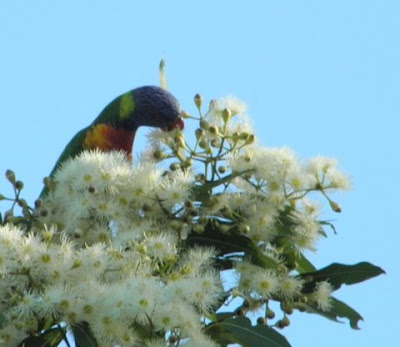 |
| Adults and at least three instars of Lychee Stink Bug, Lyramorpha rosea. |
These little beasties were found on the Small-leaved Tuckeroo Cupaniopsis parvifolia last week. They are all the same species, Lychee Stink Bug, Lyramorpha rosea. The adults are obviously the larger, less-colourful ones. However underneath they are a beautiful apple green as you can partially see on a couple of them.
sp
The smaller ones are three different stages or instars of the bug. (An instar is a developmental stage between each molt until sexual maturity is reached.) These little fellows are quite attractive in their orange and blue uniform.
sp
It is found on trees, as shown by the photograph, but also on the ground. There are lots of them on the trunk, branches and leaves of our Tuckaroo. They are sap suckers and leafeaters. There didn't seem much damage to the Tuckeroo. We'll have to keep an eye on it. Another species they like, Red Ash or Soap Tree Alphitonia excelsa has been badly attacked by something. Perhaps it is the stink bugs. They also like Leopard Ash Flindersia collina, and as its name suggests, lychees. It seems they are not a real problem in commercial orchards.
sp
An interesting fact about Shield or Stink Bugs is that the adults take care of their young. In the case of Lychee Stink Bug older instars help as well. No wonder they are so plentiful.
sp
The smaller ones are three different stages or instars of the bug. (An instar is a developmental stage between each molt until sexual maturity is reached.) These little fellows are quite attractive in their orange and blue uniform.
sp
It is found on trees, as shown by the photograph, but also on the ground. There are lots of them on the trunk, branches and leaves of our Tuckaroo. They are sap suckers and leafeaters. There didn't seem much damage to the Tuckeroo. We'll have to keep an eye on it. Another species they like, Red Ash or Soap Tree Alphitonia excelsa has been badly attacked by something. Perhaps it is the stink bugs. They also like Leopard Ash Flindersia collina, and as its name suggests, lychees. It seems they are not a real problem in commercial orchards.
sp
An interesting fact about Shield or Stink Bugs is that the adults take care of their young. In the case of Lychee Stink Bug older instars help as well. No wonder they are so plentiful.












































